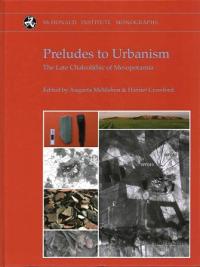
Our full catalogue is presented here by publication date. Our publications are distributed by Pen & Sword Books/Casemate Academic. Direct links to Pen & Sword Books are included in the catalogue where the book is still in print. We also sell some of our publications as e-books.
Publications
Preludes to urbanism | Living in the landscape | Rainforest foraging and farming in island Southeast Asia | The settlement at Dhaskalio | Spong Hill, part IX | Being an islander | Bones for tools – tools for bones | Why cultivate?
2015
Preludes to Urbanism: The Late Chalcolithic of Mesopotamia
edited by Augusta McMahon, Harriet Crawford
Hardback | £30 / US$44.10 | ISBN-13: 978-1-902937-65-6 | x + 196 pp. | 108 figs | 8 tables | 2015 | Buy now

This volume explores early complex society and nascent urbanism, based in studies of Mesopotamia during the fifth–fourth millennia bc. Urbanism in the Near East has traditionally been located in late fourth-millennium bc southern Mesopotamia (south Iraq); but recent excavations and surveys in northeast Syria and southeast Turkey have identified a distinctively northern Mesopotamian variant of this development, which can be dated to the early fourth millennium bc. The authors use multi-scalar approaches, including material culture-based studies, settlement archaeology and regional surveys, to achieve an understanding of the dynamics of early urbanism across this key region.
Augusta McMahon is a Senior Lecturer in Archaeology at the University of Cambridge. She has excavated widely across the Middle East, in Iraq, Syria, Egypt, Turkey and Yemen, focusing on ancient Mesopotamia in the fifth through first millennia bc. Her research focuses on the challenges and advantages of early urbanism, past violent conflict and warfare, and sensory archaeology. She was the Field Director of the Tell Brak excavations in northeast Syria from 2006 to 2011.
Harriet Crawford is a Reader Emerita of the Institute of Archaeology, University College London, and a Senior Fellow at the McDonald Institute for Archaeological Research. She has excavated extensively in Iraq and in the Gulf and has a special interest in the archaeology and history of Mesopotamia and its southern neighbours in the third millennium BCE.
2014
Living in the Landscape: Essays in Honour of Graeme Barker
edited by Katherine Boyle, Ryan J. Rabett & Chris O. Hunt
Hardback | £48 / $70.57 | ISBN 978-1-902937-73-1 | xvi + 364 pp. | 131 figs | 28 tables | 2014 | Buy now
This edited volume reflects on the multitude of ways by which humans shape and are shaped by the natural world, and how Archaeology and its cognate disciplines recover this relationship. The structure and content of the book recognize Graeme Barker’s pioneering contribution to the scientific study of human–environment interaction, and form a secondary dialectic between his many colleagues and past students and the academic vista which he has helped define. The volume comprises 22 thematic papers, arranged chronologically, each a presentation of front-line research in their respective fields. They mirror the scope of Barker’s legacy through a focus on transitions in the human–environment relationship, how they are enacted and perceived. The assembled chapters illustrate how climate, demographic, subsistence, social and ecological change have affected cultures from the Palaeolithic to Historical, from North Africa and West-Central Eurasia to Southeast Asia and China. They also chronicle the innovations and renegotiated relations that communities have devised to meet and exploit the many shifting realities involved with Living in the Landscape.
Katherine Boyle is Research Facilitator at the McDonald Institute for Archaeological Research, University of Cambridge, and an archaeozoologist specializing in the fauna of pre-Bronze Age western Europe.
Ryan J. Rabett is a Senior Research Associate and archaeozoologist at the McDonald Institute for Archaeological Research, University of Cambridge, specializing in the process of early human adaptation and colonization of different global environments including Southeast Asia, the Mediterranean and northern Canada.
Chris O. Hunt is Reader in the School of Natural Sciences and Psychology at Liverpool John Moores University and previously Reader in Palaeoecology at Queen’s University Belfast, with research interests in human–environment interrelationships in the past, and landscape change using geoarchaeology, palynology and molluscs.
2013
Rainforest foraging and farming in Island Southeast Asia: the archaeology of the Niah Caves, Sarawak
edited by Graeme Barker
Hardback | £62/US$124 | ISBN 978-1-902937-54-0 | 464 pp. | 185 figs. | 60 tables | 2013 | Buy now
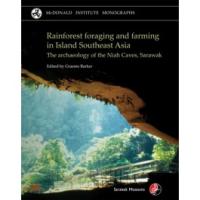
The cathedral-like Niah Caves of Sarawak (Borneo) have iconic status in the archaeology of Southeast Asia, because the excavations by Tom and Barbara Harrisson in the 1950s and 1960s revealed the longest sequence of human occupation in the region, from (we now know) 50,000 years ago to the recent past. This book is the first of two volumes describing the results of new work in the caves by a multi-disciplinary team of archaeologists and geographers aimed at clarifying the many questions raised by the earlier work.This first volume is a closely integrated account of how the old and new work combines to provide exciting new insights into the prehistory of the region: the strategies developed by our species to live in rainforest from the time of first arrival; how rainforest foragers engaged in forms of 'vegeculture' thousands of years before rice farming; and how rice farming represented profound transformations in the social lives of rainforest dwellers far more than being the dietary staple that it is today.
Graeme Barker is Disney Professor of Archaeology at the University of Cambridge and Director of the McDonald Institute for Archaeological Research. His research focuses on the relationships between past human societies and their environments and how they have transformed each other. He has worked in many different ecologies and with societies at different levels of complexity from the emergence of our species to Roman farmers and, currently in Borneo, present-day rainforest farmers and foragers.
The settlement at Dhaskalio
edited by Colin Renfrew, Olga Philaniotou, Neil Brodie, Giorgos Gavalas & Michael J. Boyd
Hardback | £80 / US$160 | ISBN 978-1-902937-64-9 | xxxii + 800 pp. | 570 figs. | 16 colour plates | 92 tables | DVD | 2013 | Buy now
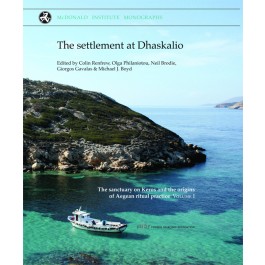
This is the first volume in the series "The Sanctuary on Keros: Excavations at Dhaskalio and Dhaskalio Kavos, 2006–2008". Here the findings are presented from the well-stratified settlement of Dhaskalio, today an islet near the Cycladic island of Keros, Greece. A series of radiocarbon dates situates the duration of the settlement from around 2750 to 2300 BC. The volume begins with a discussion of the geological setting of Keros and of sea-level change, concluding that Dhaskalio was, in the third millennium BC, linked to Keros by a narrow causeway. The excavation and finds (excluding the pottery, discussed in later volumes) are fully documented, with consideration of stratigraphy, geomorphology, organic remains, and the evidence for metallurgy. It is concluded that there was a small permanent population of around 20, increased periodically by up to 400 visitors who would have participated in the rituals of deposition occurring at the Sanctuary at Kavos, situated opposite, on Keros itself, for which the detailed evidence (including abundant fragmented pottery, marble vessels and sculptures) will be presented in Volumes II and III.
Spong Hill, part IX: chronology and synthesis
by Catherine Hills and Sam Lucy
Hardback | £59 / US $118 | ISBN 978-1-902937-62-5 | xvi + 479 pp. | 166 figs. | 70 tables | 2013 | Buy now
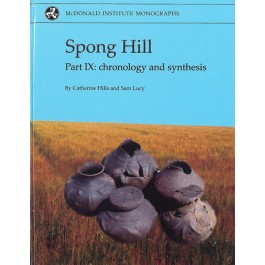
Spong Hill, with over 2500 cremations, remains the largest early Anglo-Saxon cremation cemetery to have been excavated in Britain. This volume presents the long-awaited chronology and synthesis of the site. It gives a detailed overview of the artefactual evidence, which includes over 1200 objects of bone, antler and ivory. Using this information, together with programmes of correspondence analysis of the cremation urns and the grave-goods, a revised phasing and chronology of the site is offered, which argues that it is largely fifth-century in date. The implications of this revised dating for interpretations of the early medieval period in Britain and further afield are explored in full.
Catherine Hills specializes in the archaeology of the migration period in northwestern Europe including Anglo-Saxon England. She was director of the Spong Hill excavations and post-excavation project from 1975 and author or co-author of the five catalogues of burials from the site. The finds from Spong Hill have formed the basis for much of her research on the archaeology of early Anglo-Saxon England. She is a senior lecturer in the Department of Archaeology and Anthropology at the University of Cambridge and a Fellow of Newnham College, Cambridge.
Sam Lucy specializes in early Anglo-Saxon archaeology, particularly large-scale data analysis of settlement and cemetery sites. She has published a number of major site monographs in collaboration with the Cambridge Archaeological Unit, as well as research on gender, age, ethnicity and other aspects of identity in later Roman and early Anglo-Saxon archaeology. She is a Fellow of Newnham College, Cambridge.
2012
Being an islander: production and identity at Quoygrew, Orkney, AD 900–1600
edited by James H. Barrett
Hardback | £56 / US $118 | ISBN 978-1-902937-61-8 | 416 pp. | 156 figs. | 2012 | Buy now
E-book | £29.99 | ISBN 978-1-902937-63-2 | Buy now
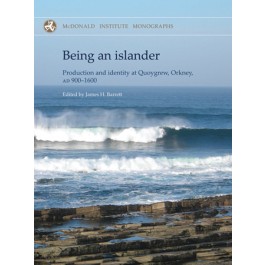
Quoygrew – a settlement of farmers and fishers on the island of Westray in Orkney – was continuously occupied from the tenth century until 1937. Focusing on the archaeology of its first 700 years, this volume explores how ‘small worlds’ both reflected and impacted the fundamental pan-European watersheds of the Middle Ages: the growth of population, economic production and trade from the tenth to the thirteenth centuries and the subsequent economic and demographic retrenchment of the fourteenth to fifteenth centuries. Concurrently, it addresses the nature of island societies, with distinctive identities shaped by the interplay of isolation and interconnectedness.
James Barrett specializes in medieval archaeology and historical ecology, with particular interests in the Viking Age, political economy, migration and the comparative study of maritime societies. He is Deputy Director of the McDonald Institute for Archaeological Research and Reader in Medieval Archaeology in the Department of Archaeology and Anthropology, University of Cambridge.
Bones for tools – tools for bones: the interplay between objects and objectives
edited by Krish Seetah and Brad Gravina
Hardback | £45 / US $90 | ISBN 978-1-902937-59-5 | xii + 164 pp. | 99 figs. | 26 tables | 2012 | Buy now
E-book | £24 | ISBN 978-1-902937-66-3 | Buy now
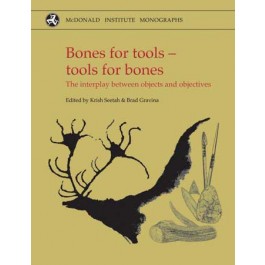
Animal procurement and tool production form two of the most tightly connected components of human behaviour. They are tied to our emergence as a genus, were fundamental to the dispersal of our species, and underpin the development of our societies. The interaction between these fundamental activities has been a subject of archaeological inference from the earliest days of the discipline, yet the pursuit of each has tended to encourage and entrench specialist study. As a result, our understanding of them has developed in full-view but in general isolation of one from the other. This volume begins the process of integrating what have all too often become isolated archaeological and interpretative domains. Exposing and exploring contexts spanning much of prehistory, and drawing data from a wide range of environmental settings, the book covers both sides of the complex inter-relationship between animals, the technologies used to procure them and those arising from them. In taking a more inclusive approach to the material, technological and social dynamics of early human subsistence we have returned to the earliest of those archaeological associations: that between stone tools and animal bones. In revealing the inter-dependence of their relationship, this volume takes what we hope will be a first step towards a revitalized understanding of the scope of past interactions between humans and the world around them.
Krish Seetah is Assistant Professor in the Department of Anthropology, Stanford University. His zooarchaeological research focuses on butchering and the socio-economic context of food.
Brad Gravina is a member of the laboratory Préhistoire a l'Actuel: Cultures, Evironment et Anthropologie (PACEA) at the University of Bordeaux. His research focuses on the final Middle Palaeolithic of Western Europe with an emphasis on lithic technology and taphonomy.
2011
Why cultivate? Anthropological and archaeological approaches to foraging–farming transitions in Southeast Asia
edited by Graeme Barker and Monica Janowski
Hardback | £35 / US $70 | ISBN 978-1-902937-58-8 | 142 pp. | 34 col. & 11 b/w figs. | 8 tables | 2011 | Buy now
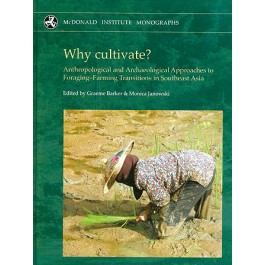
Does it make sense to understand the prehistory, history and present-day patterns of life in Southeast Asia in terms of a distinction between two ways of life: ‘farming’ and ‘foraging’? This is the central question addressed by the anthropologists and archaeologists contributing to this volume. Inherent within the question ‘Why Cultivate?’ are people’s relationships with the physical world: are they primarily to do with subsistence and economics or with social and/or cultural forces? The answers given by the contributors are complex. On a practical level they argue that there is a continuum rather than a sharp break between different levels of management of the environment, but rice-growing usually represents a profound break in people’s relations to their cultural and symbolic landscapes. An associated point made by the archaeologists is that the ‘deep histories’ of foraging-farming lifeways that are emerging in this region sit uncomfortably with the theory that foraging was replaced by farming in the mid Holocene as a result of a migration of Austronesian-speaking Neolithic farmers from southern China and Taiwan.
Graeme Barker is Disney Professor of Archaeology at the University of Cambridge and Director of the McDonald Institute for Archaeological Research. His research focuses on the relationships between past human societies and their environments and how they have transformed each other. He has worked in many different ecologies and with societies at different levels of complexity from the emergence of our species to Roman farmers and, currently in Borneo, present-day rainforest farmers and foragers.
Monica Janowski is Senior Teaching Fellow and Research Associate at the School of Oriental and African Studies (SOAS), University of London. Her research interests lie in the way people conceptualize and operationalize their relationship between themselves and the rest of the cosmos.


